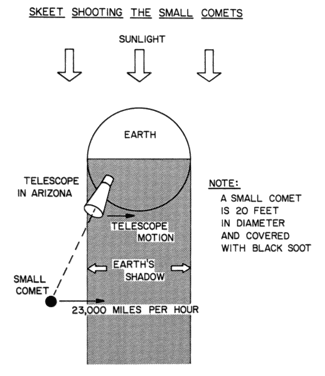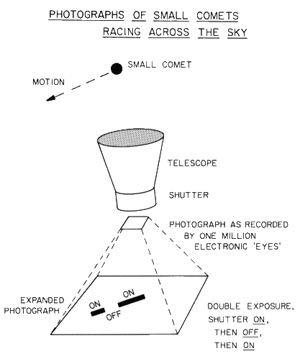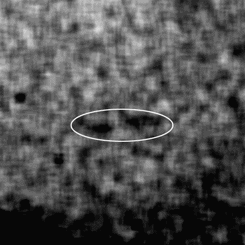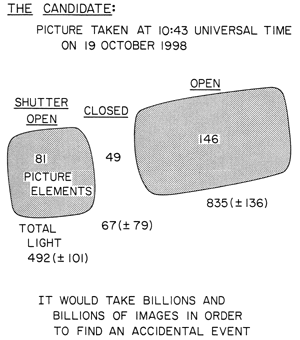|
The final frontier. In a desolate place not far from
Tombstone, Arizona is a robot telescope from the University of Iowa which
was constructed and is operated under the guidance of Robert Mutel, a
professor at our university. The building which houses the telescope is
shown in Figure 26 [below, left]. The roof of this building rolls to the
left to allow the telescope to view the sky. This telescope, the Iowa
Robotic Telescope (IRO), is seen in the photograph of Figure 27 [below,
right]. It is a matter of great coincidence, and perhaps of irony, that
this telescope can play a crucial role in the final confirmations of the
small comets.
This will not be the first search of the sky for small comets with a
ground-based telescope. About 10 years ago Clayne Yeates, a scientist at
the Jet Propulsion Laboratory in Pasadena, California designed a very
 clever way of detecting the small comets with the Spacewatch Telescope of
the University of Arizona. His method relied upon passage of small comets
by the Earth in an organized stream as inferred from the motions of
atmospheric holes observed with Dynamics Explorer 1. Clayne, like so many
other scientists in the 1980s, did not believe that the small comets
existed. His technique to detect these small, dark, fast objects is
shown in Figure 28 [left]. Telescopes are traditionally pointed so that
they are staring at the stars. In order to see the small comets Clayne
used the telescope in a "skeet shooting" manner. In other
words, the telescope's pointing was moved in such a way as to keep the
small comets in the sights of the telescope for a sufficiently long time
that they would be recorded in the images.
clever way of detecting the small comets with the Spacewatch Telescope of
the University of Arizona. His method relied upon passage of small comets
by the Earth in an organized stream as inferred from the motions of
atmospheric holes observed with Dynamics Explorer 1. Clayne, like so many
other scientists in the 1980s, did not believe that the small comets
existed. His technique to detect these small, dark, fast objects is
shown in Figure 28 [left]. Telescopes are traditionally pointed so that
they are staring at the stars. In order to see the small comets Clayne
used the telescope in a "skeet shooting" manner. In other
words, the telescope's pointing was moved in such a way as to keep the
small comets in the sights of the telescope for a sufficiently long time
that they would be recorded in the images.
To Clayne's surprise he in fact did find the small comets in his images
and in numbers that were predicted from the observations of atmospheric
holes. The small comets were clearly detected in the images. Astronomers
insisted that the comets should be detected in two consecutive
photographs. Clayne returned to the telescope and gained these pairs of
images of each small comet. Astronomers returned with the ridiculous
demand that they now needed three images. The small comets were there and
the astronomers of the Spacewatch Telescope could only offer the now
familiar "camera noise" as a defense. Because of his untimely
death Clayne was not able to continue his brilliant applications of
ground-based telescopes in the pursuit of small comets.
The Iowa telescope is now being used to verify the existence of the small
comets. The initial images already are being carefully scrutinized. In
 order to prevent any further claims of "camera noise" the image
of a small comet is taken with two exposures in the same picture. This
simple method is shown in Figure 29 [right]. The small comet is moving in
the telescope's view. A CCD sensor is placed at the focus of the
telescope in order to record the image. These sensors are found in many
of the present-day video cameras although the sensor in the Iowa
telescope has some special design features. In order to distinguish a
real comet signal from "camera noise" two exposures are taken
with a mechanical shutter. One of the exposures is twice as long as the
other and these exposures are separated by a shutter closed time equal to
the short exposure time. The result for detection of a single small comet
is two trails, one about twice as long as the other and separated by a
gap with no trail. This is shown in the lower part of Figure 29. The
ratios are not quite exact because of the small blurring due to the
telescope's resolution. Also you will note that the trails are shown as
dark, rather than bright trails. This inversion of dark and bright is
done because the human eye can detect the events more easily in the
images.
order to prevent any further claims of "camera noise" the image
of a small comet is taken with two exposures in the same picture. This
simple method is shown in Figure 29 [right]. The small comet is moving in
the telescope's view. A CCD sensor is placed at the focus of the
telescope in order to record the image. These sensors are found in many
of the present-day video cameras although the sensor in the Iowa
telescope has some special design features. In order to distinguish a
real comet signal from "camera noise" two exposures are taken
with a mechanical shutter. One of the exposures is twice as long as the
other and these exposures are separated by a shutter closed time equal to
the short exposure time. The result for detection of a single small comet
is two trails, one about twice as long as the other and separated by a
gap with no trail. This is shown in the lower part of Figure 29. The
ratios are not quite exact because of the small blurring due to the
telescope's resolution. Also you will note that the trails are shown as
dark, rather than bright trails. This inversion of dark and bright is
done because the human eye can detect the events more easily in the
images.
 An early candidate image of a small comet which was taken on October 19,
1998 is shown in Figure 30 [right]. The mottled appearance of the image
is indeed due to camera noise. This picture is presented in order to
provide the reader with an accurate accounting of the difficulties in
detecting the presence of these small dark comets, and the reasons why
these objects were not previously discovered by accident with
ground-based telescopes. At the lower border of the photograph is the
dark trail of a star. In the center of the image are the two trails of a
single small comet.
An early candidate image of a small comet which was taken on October 19,
1998 is shown in Figure 30 [right]. The mottled appearance of the image
is indeed due to camera noise. This picture is presented in order to
provide the reader with an accurate accounting of the difficulties in
detecting the presence of these small dark comets, and the reasons why
these objects were not previously discovered by accident with
ground-based telescopes. At the lower border of the photograph is the
dark trail of a star. In the center of the image are the two trails of a
single small comet.
The analysis of the image proceeds by verifying that the trails conform
to the very demanding restraints. The results of the analysis are shown
in Figure 31 [left]. It is very exciting to find the trails recorded by
more than 200 individual photoelectric eyes, or "picture
 elements", of the CCD conform to the expectations from the special
shutter operation. It would take billions of such pictures before a
"noise event" of this type would occur. We are well on our way
for the final confirmation of the existence of small comets. A large
number of such detections is necessary to complete the confirmation.
elements", of the CCD conform to the expectations from the special
shutter operation. It would take billions of such pictures before a
"noise event" of this type would occur. We are well on our way
for the final confirmation of the existence of small comets. A large
number of such detections is necessary to complete the confirmation.
Closing comments. I would like to note that it seems almost
incredible that two scientists, John Sigwarth and myself, from the
University of Iowa have participated in the four major milestones in the
discovery of small comets. Briefly these milestones are as
follows.
|
1986
|
Initial detection of small comet impacts into the atmosphere
with the Iowa camera on Dynamics Explorer 1
|
|
1989
|
Direct sightings of small comets with the Spacewatch Telescope
of the University of Arizona
|
|
1997
|
Confirmation of atmospheric impacts and discovery of
disrupting comets with the Iowa cameras on the Polar spacecraft
|
|
1999
|
Current search for small comets with the Iowa Robotic
Observatory in Arizona
|
The scientific debate concerning the existence of small comets has been
characterized by intense intellectual and emotional turmoil. I often
recall the droll statement attributed to the famous physicist Max Planck
who had also experienced considerable criticism from his colleagues.
"Scientists don't change their minds,
they just die."
[Next Page]
|
 order to prevent any further claims of "camera noise" the image
of a small comet is taken with two exposures in the same picture. This
simple method is shown in Figure 29 [right]. The small comet is moving in
the telescope's view. A CCD sensor is placed at the focus of the
telescope in order to record the image. These sensors are found in many
of the present-day video cameras although the sensor in the Iowa
telescope has some special design features. In order to distinguish a
real comet signal from "camera noise" two exposures are taken
with a mechanical shutter. One of the exposures is twice as long as the
other and these exposures are separated by a shutter closed time equal to
the short exposure time. The result for detection of a single small comet
is two trails, one about twice as long as the other and separated by a
gap with no trail. This is shown in the lower part of Figure 29. The
ratios are not quite exact because of the small blurring due to the
telescope's resolution. Also you will note that the trails are shown as
dark, rather than bright trails. This inversion of dark and bright is
done because the human eye can detect the events more easily in the
images.
order to prevent any further claims of "camera noise" the image
of a small comet is taken with two exposures in the same picture. This
simple method is shown in Figure 29 [right]. The small comet is moving in
the telescope's view. A CCD sensor is placed at the focus of the
telescope in order to record the image. These sensors are found in many
of the present-day video cameras although the sensor in the Iowa
telescope has some special design features. In order to distinguish a
real comet signal from "camera noise" two exposures are taken
with a mechanical shutter. One of the exposures is twice as long as the
other and these exposures are separated by a shutter closed time equal to
the short exposure time. The result for detection of a single small comet
is two trails, one about twice as long as the other and separated by a
gap with no trail. This is shown in the lower part of Figure 29. The
ratios are not quite exact because of the small blurring due to the
telescope's resolution. Also you will note that the trails are shown as
dark, rather than bright trails. This inversion of dark and bright is
done because the human eye can detect the events more easily in the
images.
 An early candidate image of a small comet which was taken on October 19,
1998 is shown in Figure 30 [right]. The mottled appearance of the image
is indeed due to camera noise. This picture is presented in order to
provide the reader with an accurate accounting of the difficulties in
detecting the presence of these small dark comets, and the reasons why
these objects were not previously discovered by accident with
ground-based telescopes. At the lower border of the photograph is the
dark trail of a star. In the center of the image are the two trails of a
single small comet.
An early candidate image of a small comet which was taken on October 19,
1998 is shown in Figure 30 [right]. The mottled appearance of the image
is indeed due to camera noise. This picture is presented in order to
provide the reader with an accurate accounting of the difficulties in
detecting the presence of these small dark comets, and the reasons why
these objects were not previously discovered by accident with
ground-based telescopes. At the lower border of the photograph is the
dark trail of a star. In the center of the image are the two trails of a
single small comet.
 elements", of the CCD conform to the expectations from the special
shutter operation. It would take billions of such pictures before a
"noise event" of this type would occur. We are well on our way
for the final confirmation of the existence of small comets. A large
number of such detections is necessary to complete the confirmation.
elements", of the CCD conform to the expectations from the special
shutter operation. It would take billions of such pictures before a
"noise event" of this type would occur. We are well on our way
for the final confirmation of the existence of small comets. A large
number of such detections is necessary to complete the confirmation.